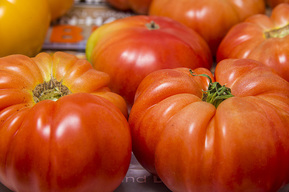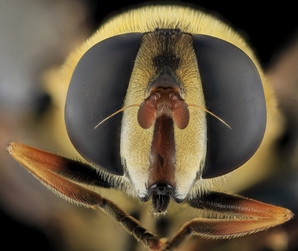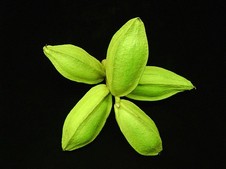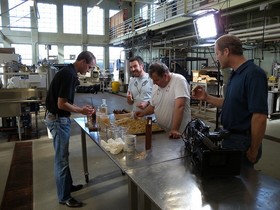|
Having trouble viewing this email? View it as a Web page.

|
|
|
Fresh from the Field is a weekly album showcasing transformative impacts made by grantees supported by the National Institute of Food and Agriculture.
Editor: Falita Liles Feb.22, 2018
|
|
Success Stories

New
'Tomato Expression Atlas' Dives Deep into the Fruit's Flesh
Tomato has been used extensively as a model for studying fruit
ripening. However, most researchers just grind up the entire fruit in their
studies and do not consider the internal tissues where the ripening process
actually starts. Scientists from Cornell University, Boyce Thompson
Institute, and USDA’s Agricultural Research Service used both
old-fashioned (hand dissection) and state-of-the-art (laser microdissection and
RNA sequencing) techniques to look at molecular and physiological basis of this
process. They discovered that the ripening program consists of gradients of
gene expression initiating in internal tissues then radiating outward, and from
the bottom of the fruit to the top where it is attached to the stem. The work explained
previously masked regulatory phenomena, including those associated with fruit texture,
color, aroma, and chemical profiles.
NIFA supports this project through the
Agriculture and Food Research Initiative.
Read the full story in the Cornell Chronicle. USDA photo by Preston Keres.
|
News Coverage
 Rooting
for the Underdogs of the Pollination World
A couple of years ago while sampling bee biodiversity, Washington
State University doctoral student Rachel Olsson noticed that bees seem to
get all the credit for pollinating, but they don’t do all the work.
“The biggest question was, ‘What is here?’” she said. “What
insects are visiting flowers? We looked at all the visits of bees and non-bees
in several different crops on these farms, including cucumbers, sunflower,
tomatoes, and buttercup to sample a weedy species.”
About a third of the insects visiting and potentially helping
pollinate these crops’ flowers were non-bee species, primarily flies. Of those,
most were syrphid flies, also known as hover flies, and they do more than
pollinate plants.
“As juveniles, they are predators of aphids, which can be
important pests on farms,” she said. “So, by recognizing their importance and
providing habitat for these flies, growers can bolster their pest management
and potentially their pollination at the same time.”
NIFA supports the research through
the Western Integrated Pest Management Center.
Read the full article at the Western IPM Center. USDA photo.
|
The Library

Biological Insecticide to Control Pecan Weevil
Pecan, a highly nutritious commodity, is the most valuable North
American native nut crop, but insect pests and diseases have limited the
ability of growers to produce organic pecans, particularly in the Southeastern
United States.
Researchers at the University of Florida discovered a
biological insecticide to control pecan weevil. Their discovery, Grandevo,
represents a breakthrough for organic and conventional producers because it is
a much sought after substitute for carbaryl (Sevin). Use of carbaryl leads to
secondary pest outbreaks and interferes with other available bio-based integrated
pest management tactics for other pests.
NIFA supports this project
through the Organic Transitions Program.
Read the full article at
Environmental Entomology USDA photo.
|
Video
 Barley in the Buff
Researchers
at Oregon State University (OSU) are giving an ancient grain a new life: this
barley is naked, but not in an indecent way. Most barley grains are covered
rather than naked. Covered varieties have a hull or outer layer firmly attached
to the grain. The hull on 'Buck'–as in "Buck-naked"–doesn't hang on
to the grain. Instead, the hulls fall off during harvest.
Food
manufacturers using covered barley grind off the unpalatable hull to produce
pearled barley. But pearling removes part of the nutrient-rich bran, and
pearled barley isn't considered a whole grain. Naked barley does not require
pearling, allowing it to hold onto the bran and whole grain status.
The
research team behind Buck crossed two barley varieties together, one from
Oregon and one from Virginia. The Oregon parent contributed desirable traits
like disease resistance, while the Virginian contributed the naked factor. The
combined traits enable Buck to achieve high yields and flourish with less
fertilizer and water than its more familiar naked cousin, wheat. Best of all,
Buck is a multi-use barley. It can be used for human food, animal feed, and
beer.
Buck
is at the forefront because it has a modest beta-glucan level that meets food,
feed, and brewing needs. If beta-glucan is too high, things get complicated for
animal nutrition and brewers. Naked barleys can produce more beer per unit of
malt used, which means breweries will get more bang for their buck.
NIFA supports this research through Organic Agriculture Research and Extension Initiative program.
Watch the OSU video from 24H News. Photo
credit: Oregon State Barley Project.
|
Tweet of the Week
#NIFAIMPACTS

|
|

NIFA’s mission is to invest in and advance agricultural research, education, and extension that solve societal challenges. NIFA’s investments in transformative science directly support the long-term prosperity and global preeminence of U.S. agriculture. To learn more about NIFA’s impact on agricultural sciences, visit www.nifa.usda.gov/Impacts, sign up for email updates or follow us on Twitter @USDA_NIFA, #NIFAImpacts.
USDA is an equal opportunity lender, provider, and employer.
|
|